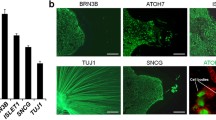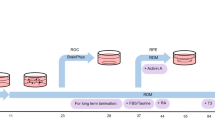Abstract
Traumatic, inherited, and age-related degenerative diseases of the retina, such as retinal detachment, glaucoma, retinitis pigmentosa, and age-related macular degeneration, are characterized by the irreversible loss of retinal neurons. Several growth factors, including glial cell-derived neurotrophic factor and pigment epithelium-derived factor, have been shown to rescue retinal neurons in animal models of retinal disease. Here we describe a scalable and robust system to study the growth factor induction in the retina: retinal organoids derived from the induced pluripotent stem cells. We have demonstrated that they secrete GDNF and PEDF at the levels tenfold above detection limit for ELISA. We also have shown that growth factor production in this system may be upregulated by specific trigger, demonstrating the feasibility of this approach for drug discovery.
Access this chapter
Tax calculation will be finalised at checkout
Purchases are for personal use only
Similar content being viewed by others
References
Caffé AR et al (2001) A combination of CNTF and BDNF rescues rd photoreceptors but changes rod differentiation in the presence of RPE in retinal explants. Invest Ophthalmol Vis Sci 42(1):275–282
Dalkara D et al (2011) AAV mediated GDNF secretion from retinal glia slows down retinal degeneration in a rat model of retinitis pigmentosa. Mol Ther 19(9):1602–1608
Decembrini S et al (2014) Derivation of traceable and transplantable photoreceptors from mouse embryonic stem cells. Stem Cell Rep 2(6):853–865
Eiraku M, Sasai Y (2012) Mouse embryonic stem cell culture for generation of three-dimensional retinal and cortical tissues. Nat Protoc 7(1):69–79
Fuller JA et al (2014) A high content screening approach to identify molecules neuroprotective for photoreceptor cells. In: Retinal degenerative diseases. Advances in experimental medicine and biology. Springer, New York, pp 773–781
LaVail MM et al (1992) Multiple growth factors, cytokines, and neurotrophins rescue photoreceptors from the damaging effects of constant light. Proc Natl Acad Sci U S A 89(23):11249–11253
Ng L et al (2011) Two transcription factors can direct three photoreceptor outcomes from rod precursor cells in mouse retinal development. J Neurosci Off J Soc Neurosci 31(31):11118–11125
Saavedra A, Baltazar G, Duarte EP (2008) Driving GDNF expression: the green and the red traffic lights. Prog Neurobiol 86(3):186–215
Sun X et al (2007) Effects of nerve growth factor for retinal cell survival in experimental retinal detachment. Curr Eye Res 32(9):765–772
Vela L et al (2016) Discovery of enhancers of the secretion of leukemia inhibitory factor for the treatment of multiple sclerosis. J Biomol Screen 21(5):437–445
Wen R et al (2012) CNTF and retina. Prog Retin Eye Res 31(2):136–151
Acknowledgments
The authors thank Tomas Minelli for helping with cell culture. This work was supported by the Alice J. Adler Fellowship of the Schepens Eye Research Institute/Eleanor and Miles Shore 50th Anniversary Fellowships for Scholars in Medicine, Bright Focus Foundation, and Department of Ophthalmology. The flow cytometry core facility is supported by the National Eye Institute core grant P30EY003790.
Author information
Authors and Affiliations
Corresponding author
Editor information
Editors and Affiliations
Rights and permissions
Copyright information
© 2018 Springer International Publishing AG, part of Springer Nature
About this paper
Cite this paper
Alavi, M., Baranov, P. (2018). The iPSc-Derived Retinal Tissue as a Tool to Study Growth Factor Production in the Eye. In: Ash, J., Anderson, R., LaVail, M., Bowes Rickman, C., Hollyfield, J., Grimm, C. (eds) Retinal Degenerative Diseases. Advances in Experimental Medicine and Biology, vol 1074. Springer, Cham. https://doi.org/10.1007/978-3-319-75402-4_75
Download citation
DOI: https://doi.org/10.1007/978-3-319-75402-4_75
Published:
Publisher Name: Springer, Cham
Print ISBN: 978-3-319-75401-7
Online ISBN: 978-3-319-75402-4
eBook Packages: Biomedical and Life SciencesBiomedical and Life Sciences (R0)




